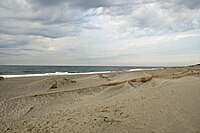
Photo from wikipedia
Abstract Wind-blown sand disasters, as an environmental problem, have great impact on human activities. Sand fence has been recognized as an efficiency technology in anti-desertification engineering and is wildly applied… Click to show full abstract
Abstract Wind-blown sand disasters, as an environmental problem, have great impact on human activities. Sand fence has been recognized as an efficiency technology in anti-desertification engineering and is wildly applied to protect highways and railways around the desert. But few people study its protection to Gobi buildings, which may also suffer from sand disaster. To study its protection to Gobi buildings, we systemically investigate the three-dimensional structure of wind field and sand distribution around sand fence for buildings by Computational Fluid Dynamic simulations and wind-tunnel experiments. The dependencies of sand-prevention efficiency on fence height, porosity, inclined slat angle and wind speed are proposed respectively. An optimal height of sand fence is suggested to be 2.0 m−2.5 m, and an optimal porosity is 10%−15%, by synthetically considering the factors of sand prevention efficiency and construction cost; the slat angles of inclined fence is recommended as 135°−150° for maximizing the sand sedimentation on the windward side of fence.
Journal Title: Aeolian Research
Year Published: 2021
Link to full text (if available)
Share on Social Media: Sign Up to like & get
recommendations!